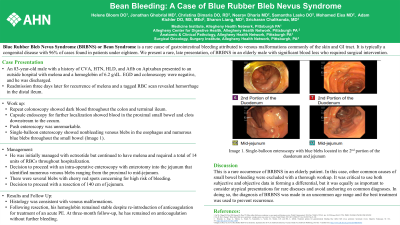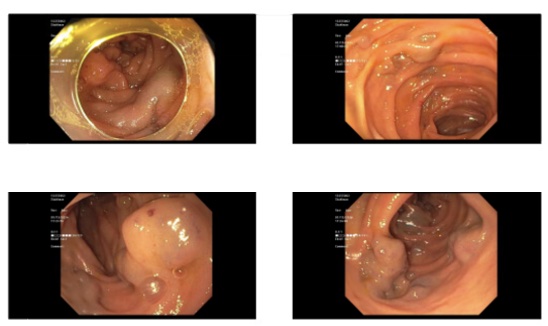Tuesday Poster Session
Category: GI Bleeding
P4204 - Bean Bleeding: A Case of Blue Rubber Bleb Nevus Syndrome
Tuesday, October 29, 2024
10:30 AM - 4:00 PM ET
Location: Exhibit Hall E

Has Audio

Helene Bloom, DO
Allegheny Health Network
Pittsburgh, PA
Presenting Author(s)
Award: Presidential Poster Award
Helene Bloom, DO1, Jonathan Ghobrial, MD2, Christina Dimaria, DO, RD3, Neerav Dharia, MD4, Samantha Lasko, DO1, Mohamed Eisa, MD1, Adam Kichler, DO, MS, MEd3, Sharon Liang, MD1, Sricharan Chalikonda, MD1
1Allegheny Health Network, Pittsburgh, PA; 2Allegheny Health Network Medicine Institute, Pittsburgh, PA; 3Allegheny Center for Digestive Health, Pittsburgh, PA; 4Allegheny General Hospital, Pittsburgh, PA
Introduction: Blue Rubber Bleb Nevus Syndrome (BRBNS) or Bean Syndrome is a rare cause of gastrointestinal bleeding attributed to venous malformations commonly of the skin and GI tract. It is typically a congenital disease with 96% of cases found in patients under eighteen. We present a rare, late presentation, of BRBNS in an elderly male with significant blood loss who required surgical intervention.
Case Description/Methods: An 83-year-old male with a history of CVA, HTN, HLD, and Afib on Apixaban presented with melena and a hemoglobin of 6.2 g/dL. EGD and colonoscopy was negative and he was discharged. He was readmitted three days later for recurrence of melena and a tagged RBC scan revealed hemorrhage in the distal ileum. Repeat colonoscopy showed dark blood throughout the colon and terminal ileum. Capsule endoscopy was completed for further localization that showed blood in the proximal small bowel and clots downstream to the cecum. A push enteroscopy was unremarkable, therefore a single-balloon enteroscopy was completed showing nonbleeding venous blebs in the esophagus and numerous blue blebs throughout the small bowel. He was initially managed with octreotide but continued to have melena. As he required a total of 14 units of RBC’s throughout hospitalization, it was decided to proceed with an intra-operative enteroscopy with enterotomy into the jejunum that identified numerous venous blebs ranging from the proximal to mid-jejunum. There were several blebs with cherry red spots concerning for high risk of bleeding. As the venous blebs were determined to be the source and given that the patient would have a remaining 270 cm of small bowel remaining after resection, it was decided to proceed with a resection of 140 cm of jejunum. Histology was consistent with venous malformations. Following resection, his hemoglobin remained stable despite re-introduction of anticoagulation for treatment of an acute PE. At three month follow-up, he has remained on anticoagulation without further bleeding.
Discussion: This is a rare occurrence of BRBNS in an elderly patient. In this case, other common causes of small bowel bleeding were excluded with a thorough workup. It was critical to use both subjective and objective data in forming a differential, but it was equally as important to consider atypical presentations for rare diseases and avoid anchoring on common diagnoses. In doing so, the diagnosis of BRBNS was made in an uncommon age range and the best treatment was used to prevent recurrence.

Disclosures:
Helene Bloom, DO1, Jonathan Ghobrial, MD2, Christina Dimaria, DO, RD3, Neerav Dharia, MD4, Samantha Lasko, DO1, Mohamed Eisa, MD1, Adam Kichler, DO, MS, MEd3, Sharon Liang, MD1, Sricharan Chalikonda, MD1. P4204 - Bean Bleeding: A Case of Blue Rubber Bleb Nevus Syndrome, ACG 2024 Annual Scientific Meeting Abstracts. Philadelphia, PA: American College of Gastroenterology.
Helene Bloom, DO1, Jonathan Ghobrial, MD2, Christina Dimaria, DO, RD3, Neerav Dharia, MD4, Samantha Lasko, DO1, Mohamed Eisa, MD1, Adam Kichler, DO, MS, MEd3, Sharon Liang, MD1, Sricharan Chalikonda, MD1
1Allegheny Health Network, Pittsburgh, PA; 2Allegheny Health Network Medicine Institute, Pittsburgh, PA; 3Allegheny Center for Digestive Health, Pittsburgh, PA; 4Allegheny General Hospital, Pittsburgh, PA
Introduction: Blue Rubber Bleb Nevus Syndrome (BRBNS) or Bean Syndrome is a rare cause of gastrointestinal bleeding attributed to venous malformations commonly of the skin and GI tract. It is typically a congenital disease with 96% of cases found in patients under eighteen. We present a rare, late presentation, of BRBNS in an elderly male with significant blood loss who required surgical intervention.
Case Description/Methods: An 83-year-old male with a history of CVA, HTN, HLD, and Afib on Apixaban presented with melena and a hemoglobin of 6.2 g/dL. EGD and colonoscopy was negative and he was discharged. He was readmitted three days later for recurrence of melena and a tagged RBC scan revealed hemorrhage in the distal ileum. Repeat colonoscopy showed dark blood throughout the colon and terminal ileum. Capsule endoscopy was completed for further localization that showed blood in the proximal small bowel and clots downstream to the cecum. A push enteroscopy was unremarkable, therefore a single-balloon enteroscopy was completed showing nonbleeding venous blebs in the esophagus and numerous blue blebs throughout the small bowel. He was initially managed with octreotide but continued to have melena. As he required a total of 14 units of RBC’s throughout hospitalization, it was decided to proceed with an intra-operative enteroscopy with enterotomy into the jejunum that identified numerous venous blebs ranging from the proximal to mid-jejunum. There were several blebs with cherry red spots concerning for high risk of bleeding. As the venous blebs were determined to be the source and given that the patient would have a remaining 270 cm of small bowel remaining after resection, it was decided to proceed with a resection of 140 cm of jejunum. Histology was consistent with venous malformations. Following resection, his hemoglobin remained stable despite re-introduction of anticoagulation for treatment of an acute PE. At three month follow-up, he has remained on anticoagulation without further bleeding.
Discussion: This is a rare occurrence of BRBNS in an elderly patient. In this case, other common causes of small bowel bleeding were excluded with a thorough workup. It was critical to use both subjective and objective data in forming a differential, but it was equally as important to consider atypical presentations for rare diseases and avoid anchoring on common diagnoses. In doing so, the diagnosis of BRBNS was made in an uncommon age range and the best treatment was used to prevent recurrence.

Figure: Single balloon enteroscopy with blue blebs located in the 2nd portion of the duodenum and mid-jejunum.
Disclosures:
Helene Bloom indicated no relevant financial relationships.
Jonathan Ghobrial indicated no relevant financial relationships.
Christina Dimaria indicated no relevant financial relationships.
Neerav Dharia indicated no relevant financial relationships.
Samantha Lasko indicated no relevant financial relationships.
Mohamed Eisa indicated no relevant financial relationships.
Adam Kichler indicated no relevant financial relationships.
Sharon Liang indicated no relevant financial relationships.
Sricharan Chalikonda indicated no relevant financial relationships.
Helene Bloom, DO1, Jonathan Ghobrial, MD2, Christina Dimaria, DO, RD3, Neerav Dharia, MD4, Samantha Lasko, DO1, Mohamed Eisa, MD1, Adam Kichler, DO, MS, MEd3, Sharon Liang, MD1, Sricharan Chalikonda, MD1. P4204 - Bean Bleeding: A Case of Blue Rubber Bleb Nevus Syndrome, ACG 2024 Annual Scientific Meeting Abstracts. Philadelphia, PA: American College of Gastroenterology.

